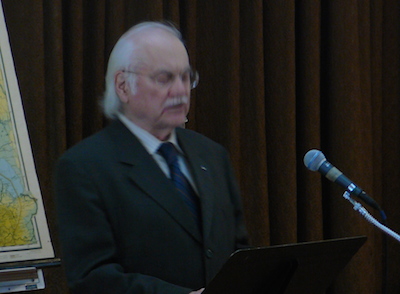It's called “Kodumuld”. An English version might be called “A Handful of Earth from Home”. It has brought tears to many an eye and for some, the words and melodic phrases have made it emotionally challenging to sing.
Composed during the early years of exile by Paul Tammeveski and set to deeply personal lyrics by Ilmar Rebane, the song has been around for almost 70 years. When invited recently by Vancouver Estonians to address an audience at “Meie Kodu” (church and community centre), I decided to integrate ,,Kodumuld” with my childhood Great Escape story.
Another channel for perceiving the Escape is geographic memory as the route and points of departure become fixed in one's mind. This visual recollection contributed to the importance placed on maps of Eesti printed in exile. In my description of our family's escape I naturally used a large old school map which enabled me to point to five different ports and harbours on the mainland and the islands that were part of our family's escape path. While looking for a wall-map of a reasonable size, I found that the Vancouver Estonian centre had at least four of them.
As a result of the loss of a homeland, the physical void had to be replaced by this iconic form that most Estonians, even children, are able to reproduce by memory. During the emergence of freedom's vision in the late 80's, a song referring to Estonia's map became somewhat popular. In Toronto, it was performed by my musical friend Andres Tamm. Mind you, geographical references are rather common in vocal music of the past centuries. One of the earliest such songs, set to a rousing French provincial anthem, begins by asking if we know a land stretching from Lake Peipsi to the west coast shoreline – for many, years later, the dangerous escape route toward a welcoming but equally dangerous sea.
While I was searching for another identifying view of the Escape, my wife suggested the Estonian flag. Of course! Since the blue-black and white was torn down during the brief time it flew over Tallinn during the hiatus between the occupying armies, one withdrawing , the other advancing, it had to rise again somewhere. That somewhere was exile.
As a result, that flag found a new home in churches, community centres and especially in youth camps, where it was hoisted regularly into the sunshine of a bright summer morning. In Estonia, possession of it could have resulted in severe punishment for the owner. So it might have been hidden in attics or, more likely, buried, deep in the ground, but still alive in the hearts of the people.
The Great Escape of '44 marked the beginning of a long political struggle for freedom lost and eventually regained. This struggle was fortified by these shared values and treasured identifying symbols. Recent commemorations in Eesti and abroad represent a nation's determination to forge its own future in spite of centuries-long foreign colonial oppression.
Andres Raudsepp
